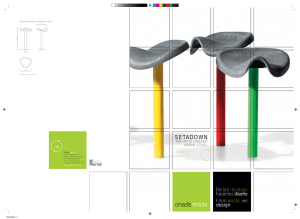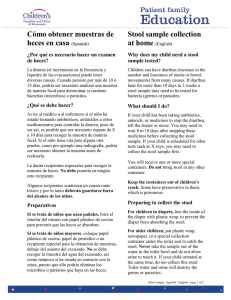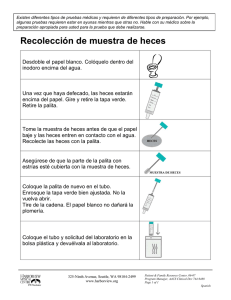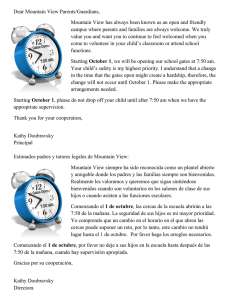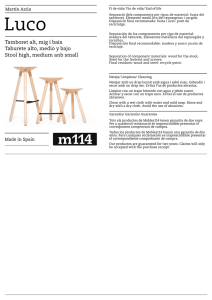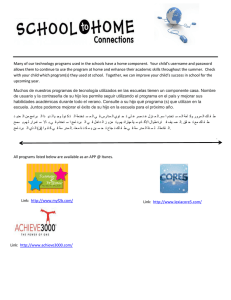PE810S Stool Test: Tips for collecting a stool sample
Anuncio
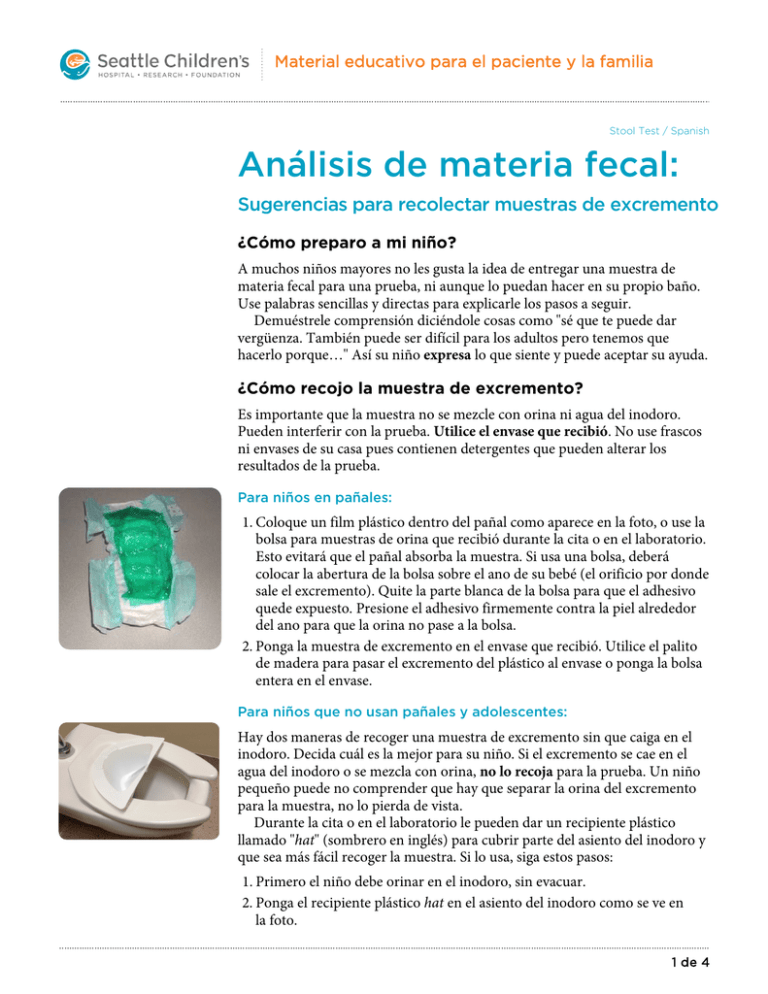
Material educativo para el paciente y la familia Stool Test / Spanish Análisis de materia fecal: Sugerencias para recolectar muestras de excremento ¿Cómo preparo a mi niño? A muchos niños mayores no les gusta la idea de entregar una muestra de materia fecal para una prueba, ni aunque lo puedan hacer en su propio baño. Use palabras sencillas y directas para explicarle los pasos a seguir. Demuéstrele comprensión diciéndole cosas como "sé que te puede dar vergüenza. También puede ser difícil para los adultos pero tenemos que hacerlo porque…" Así su niño expresa lo que siente y puede aceptar su ayuda. ¿Cómo recojo la muestra de excremento? Es importante que la muestra no se mezcle con orina ni agua del inodoro. Pueden interferir con la prueba. Utilice el envase que recibió. No use frascos ni envases de su casa pues contienen detergentes que pueden alterar los resultados de la prueba. Para niños en pañales: 1. Coloque un film plástico dentro del pañal como aparece en la foto, o use la bolsa para muestras de orina que recibió durante la cita o en el laboratorio. Esto evitará que el pañal absorba la muestra. Si usa una bolsa, deberá colocar la abertura de la bolsa sobre el ano de su bebé (el orificio por donde sale el excremento). Quite la parte blanca de la bolsa para que el adhesivo quede expuesto. Presione el adhesivo firmemente contra la piel alrededor del ano para que la orina no pase a la bolsa. 2. Ponga la muestra de excremento en el envase que recibió. Utilice el palito de madera para pasar el excremento del plástico al envase o ponga la bolsa entera en el envase. Para niños que no usan pañales y adolescentes: Hay dos maneras de recoger una muestra de excremento sin que caiga en el inodoro. Decida cuál es la mejor para su niño. Si el excremento se cae en el agua del inodoro o se mezcla con orina, no lo recoja para la prueba. Un niño pequeño puede no comprender que hay que separar la orina del excremento para la muestra, no lo pierda de vista. Durante la cita o en el laboratorio le pueden dar un recipiente plástico llamado "hat" (sombrero en inglés) para cubrir parte del asiento del inodoro y que sea más fácil recoger la muestra. Si lo usa, siga estos pasos: 1. Primero el niño debe orinar en el inodoro, sin evacuar. 2. Ponga el recipiente plástico hat en el asiento del inodoro como se ve en la foto. 1 de 4 Análisis de materia fecal: sugerencias para recolectar muestras de excremento 3. Pídale a su niño que evacue en el recipiente de recolección. 4. Utilice el palito de madera que recibió para pasar el excremento al envase de recolección. Ponga la última parte del excremento, la más blanda, en el envase de recolección. 5. Si a su niño le queda excremento colgando, en lugar de limpiarlo, recójalo con el palo de madera y póngalo también en el envase. La muestra también se puede recoger estirando un film plástico sobre el inodoro como se ve en la foto. 1. Levante el asiento del inodoro y cúbralo todo con mucho plástico. Si no se pega al inodoro, use cinta adhesiva. 2. Hunda un poco el plástico para formar un espacio donde caiga el excremento. 3. Baje el asiento para que su niño evacúe sobre el plástico. 4. Con el palo de madera, pase la última parte del excremento del inodoro al envase de recolección. El tipo de prueba de excremento para su niño está marcada abajo. Por favor siga las instrucciones. Prueba de grasa de 72 horas Cantidad necesaria: recolecte todo el excremento de su niño por las próximas 72 horas. Solo llene el vaso hasta la mitad. Utilice un segundo vaso si es necesario. Sugerencias para recolección y manejo: • Mantenga el envase refrigerado hasta que lo traiga al laboratorio. • El excremento se debe recoger en el envase del laboratorio que ha sido previamente pesado; no use ningún otro envase. • Su niño no debe tomar laxantes como aceite de ricino, aceite mineral ni substituto de grasa en su dieta por 3 días antes de la recolección de excrementos. Cultivo Bacterial Cantidad necesaria: recoger excrementos del tamaño de una nuez o una pelota de 1 pulgada. Sugerencias para la recolección y el manejo: • No utilice cotonetes rectales (hisopos) para recoger la muestra. • Las muestras del pañal se deben recoger usando el método del film plástico que se explica arriba. • Mantenga el envase refrigerado hasta que lo traiga al laboratorio. • Después de recoger la muestra, tráigala al laboratorio antes de que pase 1 hora. Si no puede entregarla antes de 1 hora, la muestra se puede refrigerar hasta por 8 horas. • En la muestra se analiza: Salmonella, Shigella, Campylobacter jejuni, Yersinia enterocolítica y E. coli 0157. 2 de 4 Análisis de materia fecal: sugerencias para recolectar muestras de excremento Sangre oculta en materia fecal Cantidad necesaria: recoger excremento del tamaño de una nuez, de una pelota de 1 pulgada o del tamaño de la tarjeta de hemocultivo (que recibió en la cita). Sugerencias para la recolección y el manejo: • Evite darle a su niño carnes rojas, nabos (turnips), rábanos, vitamina C (más de 250 mg/día), aspirinas y antiinflamatorios antes de recoger la muestra. • Los alimentos que se recomiendan son: pequeñas cantidades de pollo y atún, frutas y verduras cocidas, cacahuates, palomitas de maíz, cereal de salvado. • Mantenga el envase refrigerado hasta que lo traiga al laboratorio. Grasa en el excremento: una sola recolección Cantidad necesaria: recoger excrementos del tamaño de una nuez o una pelota de 1 pulgada. Sugerencias para la recolección y el manejo: • Su niño no puede tomar laxantes como aceite de ricino, aceite mineral ni substituto de grasa en su dieta por 3 días antes de la recolección del excremento. • Las muestras de pañal se deben tomar utilizando el método del film plástico que se explica arriba. • El excremento debe ser reciente; menos de 48 horas. • Mantenga el envase refrigerado hasta que lo traiga al laboratorio. Prueba de huevos y parásitos Cantidad necesaria: recoger excrementos del tamaño de un frijol pequeño o un chícharo (pea). Sugerencias para la recolección y el manejo de excrementos recientes: • Después de recogerla, traiga la muestra al laboratorio antes de que pase 1 hora. Si no puede entregarla antes de 1 hora, la puede refrigerar hasta por 8 horas. • No utilice cotonetes rectales (hisopos) para recoger la muestra. • Las muestras de pañal se deben recoger usando el método del film plástico que se explica arriba. • Recoja el excremento antes de un procedimiento con bario o después de 5 días como mínimo. • Si no se detectan parásitos en la primera muestra, le podemos pedir una segunda o una tercera muestra. Entre una muestra y otra debe haber un mínimo de 72 horas. • Consejos para la recolección y manejo cuando se usa un envase EcoFix con solución conservante para la prueba de huevos y parásitos: 1. Abra el envase que contiene el conservante líquido. Utilice la cuchara de recolección, que está en la tapa, para colocar pequeñas cantidades de materia fecal en el envase. Tome una muestra de la última parte del 3 de 4 Análisis de materia fecal: sugerencias para recolectar muestras de excremento Para más información • Laboratorio 206-987-2102 • Consulte con el proveedor de atención médica de su hijo • www.seattlechildrens.org excremento de su niño y coloque suficiente cantidad para que el contenido suba hasta la línea roja. 2. Mantenga la solución fuera del alcance de su niño. El líquido es tóxico. Si le toca la piel o los ojos, enjuague el área con agua. Si la piel o los ojos siguen irritados, llame al proveedor de atención médica de su niño. 3. Es peligroso tragar la solución. Si su niño la traga, llévelo a Emergencias inmediatamente. Manténgalo observado para asegurarse de que respira normalmente. Lleve con usted el envase y la etiqueta para que su niño reciba tratamiento. Otras recolecciones especiales de materia fecal para pH, azúcares reductores y concentración de cloruro Servicio gratuito de intérprete • Estando en el hospital, solicítelo con la enfermera de su niño. • Fuera del hospital, llame a la línea gratuita de interpretación 1-866-583-1527. Dígale al intérprete la extensión o el nombre de la persona que necesita. • Después de recogerla, traiga la muestra al laboratorio antes de que pase 1 hora. • Las muestras de pañal se deben recoger utilizando el método del film plástico que se explica arriba. Si tiene preguntas acerca del proceso de recolección de excrementos, puede contactar al Laboratorio al 206-987-2102. ¿Cuándo y dónde dejo la muestra? Las muestras se pueden entregar en los laboratorios de las sedes durante los siguientes horarios: Laboratorio de Seattle Children’s, Ocean 8: De lunes a viernes: 7 a.m. a 10 p.m. Fines de semana y feriados: 8 a.m. a 8 p.m. Laboratorio del Centro Clínico y Quirúrgico de Bellevue: De lunes a viernes: 7:30 a.m. a 6:30 p.m. Sábado: 9 a.m. a 5:30 p.m. (cerrado: domingos y feriados) Laboratorio del Sur Clínico: De lunes a viernes: 7:30 a.m. a 6:30 p.m. Sábados: 9 a.m. a 5:30 p.m. (cerrado: domingos y feriados) ¿Cuándo tendremos los resultados? Los resultados se envían al médico que ordenó la prueba. El pediatra le explicará los resultados de la prueba y contestará sus preguntas. Contacte al pediatra de su niño para su seguimiento médico. Seattle Children’s ofrece servicio de interpretación gratuito para pacientes, familiares y representantes legales sordos, con problemas de audición o con inglés limitado. Seattle Children's tendrá disponible esta información en formatos alternativos bajo solicitud. Llame al Centro de Recursos Familiares al 206-987-2201. Esta información ha sido revisada por personal clínico de Seattle Children's. Sin embargo, como las necesidades de su niño son únicas, antes de actuar o depender de esta información, por favor consulte con el médico de su hijo. © 2008, 2010, 2013, 2015 Seattle Children’s, Seattle, Washington. Todos los derechos reservados. Laboratorio 12/15 Tr (jw/lv) PE810S 4 de 4 Patient and Family Education Stool Test Tips for collecting a stool sample How can I prepare my child? Many older children do not like the idea of giving a sample of their stool for testing, even if they can do it in their own bathroom. Talk to your child about the steps using simple, honest words. Show them you understand by saying something like “I know this may be embarrassing for you. It can be awkward for grownups too, but we need to do this because…” This will allow your child to express their feelings and accept your help. How do I collect a stool sample? It is important that no urine or toilet water mix with the stool sample. These can interfere with testing. Please use the collection container given to you. Do not use jars or containers from home. They have detergents in them that can change the results of your child’s tests. For children in diapers: 1. Line the inside of diaper with plastic wrap, as shown, or use a (urine) collection bag given to you by clinic or the lab. This will keep the stool sample from being absorbed into the diaper. If you use a collection bag, you will need to place the opening of the bag over your baby’s anus (the hole where the stool comes out). Peel off the white sticker from the bag to expose the adhesive. Press the adhesive firmly on to the skin around the anus to keep any urine from getting into the bag. 2. Put the stool sample into the collection container given to you. Use the wooden stick given to you to transfer the stool from the plastic wrap into the collection container, or put the entire collection bag into the container. For toilet-trained children and teens: There are two ways to collect a stool sample. Both options prevent the sample from falling into the toilet. Pick the one that will work best for your child. If the stool falls into the toilet water or is mixed with urine, do not collect it for testing. Watch your child if they are young and might not understand that their urine must be kept separate from the stool being collected. The clinic or lab can provide you with a plastic collection device called a “hat” to help you collect the stool sample. The hat covers part of the toilet seat to make it easier to collect. If you choose to use a hat, follow these steps: 1. First have your child urinate into the toilet, without pooping. 2. Put the collection hat onto the toilet seat as pictured. 3. Ask your child to then poop into the collection hat. 1 of 4 Stool Test: Tips for collecting a stool sample 4. Use the wooden stick given to you to transfer the stool from the hat into the collection container. Put the last part of the stool, the softest part, into the collection container. 5. If some stool is still hanging from your child’s bottom, instead of wiping it off, collect it using the wooden stick we gave you and put it in the container too. You can also collect a stool sample by stretching plastic wrap over the toilet as shown. 1. Lift the toilet seat and cover the entire bowl with a large sheet of plastic wrap. If the plastic wrap does not stick to the toilet, you may need to use tape to secure it. 2. Make a small dip in the plastic so there is a place for the stool to collect. 3. Lower the toilet seat cover and have your child poop onto the plastic wrap. 4. Using the wooden stick given to you, transfer the last part of the stool into the collection container given to you. The type of stool test your child is having is checked below. Please follow the instructions given. 72-Hour Stool Fat Amount needed: collect all of your child’s stool over the next 72 hours. Only fill the container until it is half full. Then use a second container if needed. Collection and handling tips: • Keep the container refrigerated until you bring it to the lab. • Stool must be collected in the pre-weighed container from the lab; no other containers can be used. • Your child may not have laxatives, such as mineral or castor oils, or fat substitutes in their diet for 3 days before the stool collection Bacterial Culture Amount needed: collect stool the size of a walnut or a 1-inch ball. Collection and handling tips: • Do not use rectal swabs to collect the sample. • Diaper samples must be collected using the plastic wrap collection method described above. • Keep the container refrigerated until you bring it to the lab. • Bring the sample to the lab within 1 hour of collection. If you are unable to deliver the sample within 1 hour, the sample may be refrigerated for up to 8 hours. • The sample will be tested for: Salmonella, Shigella, Campylobacter jejuni, Yersinia enterocolitica and E. coli 0157. 2 of 4 Stool Test: Tips for collecting a stool sample Stool (Occult) Blood Amount needed: collect stool the size of a walnut or 1-inch ball or to fit on to a Hemoccult card (given to you by the doctor or clinic). Collection and handling tips: • Avoid feeding your child red meat, turnips, horseradish, vitamin C (in excess of 250 mg/day), aspirin and anti-inflammatory medicine before you collect the sample. • Recommended foods are: small amounts of chicken and tuna, cooked fruits and vegetables, peanuts, popcorn, bran cereal. • Keep the container refrigerated until you bring it to the lab. Stool Fat – one time collection Amount needed: collect stool the size of a walnut or 1-inch ball. Collection and handling tips: • Your child may not have laxatives, such as mineral or castor oils, or fat substitutes in their diet for 3 days before the stool collection. • Diaper samples must be collected using the plastic wrap collection method described above. • Stool must be fresh; less than 48 hours old. • Keep the container refrigerated until you bring it to the lab. Ova and Parasite examination Amount needed: collect stool the size of a small bean or pea. Collection and handling tips for fresh stool: • Bring the sample to the lab within 1 hour of collection. If you are unable to deliver the sample within 1 hour, the sample may be refrigerated for up to 8 hours. • Do not use rectal swabs to collect the sample. • Diaper samples must be collected using the plastic wrap collection method described above. • Collect stool before, or at least 5 days after, your child has had a barium procedure. • If no parasites are seen in the first sample, you may be asked to get a second and third sample. Samples should be collected at least 72 hours apart. • Collection and handling tips when using an EcoFix container with preservative solution for the ova and parasite test: 1. Open the container that contains the liquid preservative. Use the collection spoon built into the lid to place small scoopfuls of stool into the container. Take a sample from the last part of the stool that your child produced. Place enough stool in the solution so that the contents rise to the red line on the container. 3 of 4 Stool Test: Tips for collecting a stool sample To Learn More • Laboratory 206-987-2102 • Ask your child’s healthcare provider • www.seattlechildrens.org 2. Keep the solution away from your child. The liquid is poisonous. If it gets on the skin or in the eyes, rinse the area with water. If the skin or eyes are still irritated, call your child’s healthcare provider. 3. It is unsafe to swallow the solution. If your child swallows it, take them to the emergency room right away. Watch them to make sure they are breathing normally. Bring the container and label with you when your child is treated. Other special stool collections for Stool pH, Stool Reducing Substances and Stool Chloride Free Interpreter Services • Bring the sample to the lab within 1 hour of collection. • Diaper samples must be collected using the plastic wrap collection method described above. • In the hospital, ask your child’s nurse. If you have additional questions about the stool collection process, you may contact the Laboratory at 206-987-2102. • From outside the hospital, call the toll-free Family Interpreting Line 1-866-583-1527. Tell the interpreter the name or extension you need. When and where can I drop off a sample? Samples may be delivered to the lab during the following hours: Seattle Children’s Ocean 8 Laboratory: Monday through Friday: 7 a.m. to 10 p.m. Weekends and holidays: 8 a.m. to 8 p.m. Bellevue Clinic and Surgery Center Laboratory: Monday through Friday: 7:30 a.m. to 6:30 p.m. Saturday: 9 a.m. to 5:30 p.m. (Closed: Sunday and holidays) South Clinic Laboratory:. Monday through Friday: 7:30 a.m. to 6:30 p.m. Saturday: 9 a.m. to 5:30 p.m. (Closed: Sunday and holidays) When will I know about the test results? Results are sent to the doctor who ordered your child’s test. Your child’s doctor will explain the test results and answer your questions. Please contact your child’s doctor for follow-up. Seattle Children’s offers interpreter services for Deaf, hard of hearing or non-English speaking patients, family members and legal representatives free of charge. Seattle Children’s will make this information available in alternate formats upon request. Call the Family Resource Center at 206-987-2201. This handout has been reviewed by clinical staff at Seattle Children’s. However, your child’s needs are unique. Before you act or rely upon this information, please talk with your child’s healthcare provider. © 2008, 2010, 2013, 2015 Seattle Children’s, Seattle, Washington. All rights reserved. Laboratory 12/15 PE810 4 of 4
